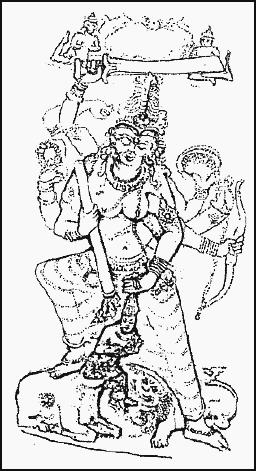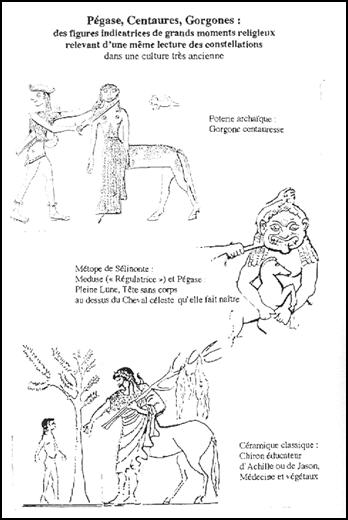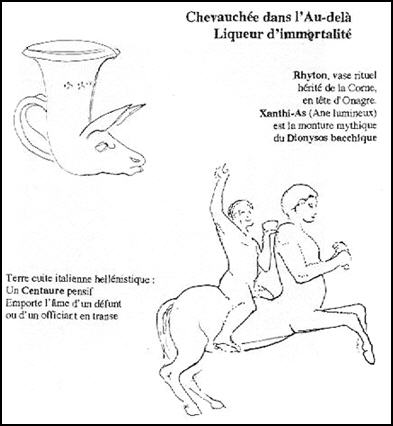
to compose sequences of « myth cinema »
TABLE OF CONTENTS
Home page
The awaited return of the most obvious seasonal signal
The "brilliant" sectors of the sky
An assembly of sacred images
Figures portrayed
by stars in the night,
by nature "dramatic" figures
Why make reference to
seasonal stars.
Measuring time in "moons"
When lunar imagery is combined
with stellar imagery to compose
a "mythical cinema"
The human condition
and its development
in the
collective memory
More
French version
The frontons or metopes of Greek temples show the Gorgon, Medusa, giving birth to Pegasus. Greek pottery shows Athena, who succeeded her and kept her image on her breastplate, with drawings or sculpture of a white horse.
Once again, these figures are significant: the lunar power, sovereign of the calendar and mistress of all creative thought, draws her designs in the night sky. Our whole study tends to show that it is precisely these composite images created by the association of the Moon with constellations that signal the start of sacred religious periods.
Relief sculpture at the Silaur Temple in India deserves close attention: it shows how the arrival of the Moon can build a composite image.
Durga is the divinity that gives rise to this image. She is said to be the wife of Shiva, the celestial Power, whose dance is the motor that drives the Universe. In Bengal there are five days of great festivities in autumn where she is asked to come down from the sky. The final solemn moment is the "goddess’ bath" using an effigy, which is comparable to Hera’s bath in Samos or Sarah’s bath in Saintes Maries de la Mer.
Durga is also Chandra, Tchandra (Kand: white light). The Moon. At Silaur she is surrounded by her attributes: the Saint James Shell, an arc and she is accompanied by a feline. Above her are the pair of celestial announcers, the Gemini, who hover over her action. In other words they are on the banks of the Milky Way.
In full glory, she dominates the body of a decapitated quadruped with a large star on its backbone. Pulling it by the hair, she removes the bust of a human from the animal’s withers.

This scene is currently interpreted as representing a beneficial and divine act: the goddess extracts Mahisha (The Very Great, the Giant) from the demonic buffalo form he had taken on in ancient times.
Yet in other representations this same Very Great Mahisha is portrayed as a Minotaur, in exactly the same position as on well-known Greek pottery.
The sculpture of Silaur consequently takes on all of its true meaning: it illustrates a precise religious moment. The Lunar Power is no longer a minotaur, "The Moon in Taurus". In the Moon’s autumnal 4-night visit to the brilliant sector of the sky, still traveling from right to left, it passes the house of entry, the house of the Buffalo Head. It is at its moment of fullness when it arrives on top of the bust of the Giant.
To return to the Bath in the Galaxy, which will be celebrated in ritual, the Moon must travel through the rest of the stellar alignment composed of Sirius and the Belt of Orion. The transcription of this alignment is the body of a quadruped, bovine or equine, the great steed whose "strike of the hoof" (as we saw with Pegasus) marked the springing forth of the Nebula.
At Silaur the grafting of a human bust (trapezoidal from the front) on the body of a quadruped, Candra-Moon produces a composite figure that bears part of its name :
Kand Aor , Kent Auros, Gand Arva,
a
Centaur.
This prestigious ideogram is the representative icon of an advanced culture occupying the geographical area from Asia to Central Europe, apparently developed by the first nomadic herders, for whom bovines and horses were of vital importance.
Consequently, Dumezil was correct to assimilate the image and name of Gandharva in India with that of Kentauros of Thrace. If examined attentively through their myths, the appearance of the two entities (in India: among others, the divine loves and wedding of Pururavas, the Hunter, and Urvasi, the celestial apsaras or nymph; in Greece, Ixion, the lover of the Nebula, Chiron the Wise; the Wedding of Thetis and Peleus, which assembled gods and men as a prelude to the Trojan War; Nessus and the poisoned Tunic, etc.) as well as their figurative sources (pottery and sculpture) concord to the point of giving us a glimpse of what appears to be one and the same culture.
A culture that is both rich and full of contrasts: imbued with a sort of sidereal mysticism and a great love of music, wide-ranging knowledge, particularly of medicinal plants, associated with sacrificial rites and hierogamic rites of great violence, where exhilarating beverages played a major role.

This culture appears to hold the image of the Centaur as one of the last avatars of the prehistoric celestial steed that carries souls not only into Shamanistic trances, but also away to death. A Hellenistic Italian statuette represents a contemplative Centaur carrying a small human figure who raises a cup (the elixir of life or potion of immortality?): it corresponds perfectly to the current meaning of the Indian word Gandharva, which designates the soul’s capacity of living forever through reincarnations.

The Indian myth of the "Wedding of Urvasi" may give the date in the cycle of seasons of the ceremony symbolized by the image of the Centaur/Gandharva. The Infant Ayush (Force of Life) was born of the loves of the human Hunter and the "Beautiful Urvasi". This divine mother dances in the heavens, and is both a wave of fluid (apsaras, Ps : water, psar: fish) and the vibration of a musical tone.
As witness to the presence of the divine in earthly creatures, the Newborn appears in the Palace of the Gandharvas during the celebration of "the Last Night of the Year", "Saratanim Ratrim". The Centaur-like image therefore seems to allude to a very ancient "Christmas" in the epoch of the "the Grand Goddess", when the Celestial Creative Power was considered to be feminine. Occurring on the frontiers of Greek culture and being a figure so closely linked to the religious calendar, the Centaur could not avoid competing with Herakles (Myth of Herakles and Nessus, where Orion is interpreted as wearing a brilliant Tunic and passing through a galactic celestial River): Hercules and the Centaur are relegated to the museum of "Old Moons" by Apollo, the great harmonizer of seasonal rites.
Even later, when it became necessary to draw up a complete map of the sky, their images are used to designate constellations that have no relationship to their original stars. We remember, however, that even though placed in a Zodiac divided into twelve standardized sections, the Centaur – now Sagittarius – was believed by the ancients to have been involved with souls moving up the Milky Way.